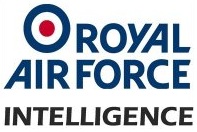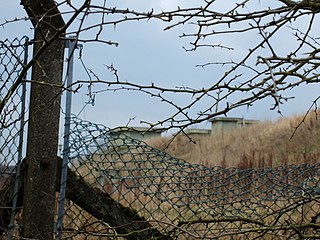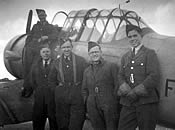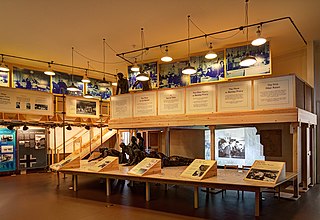
Royal Air Force Mona, or more simply RAF Mona, is a Royal Air Force station near Bodffordd on the island of Anglesey, Wales. It is primarily used as a relief landing ground for RAF Valley.

The Women's Auxiliary Air Force (WAAF), whose members were referred to as WAAFs, was the female auxiliary of the British Royal Air Force during World War II. Established in 1939, WAAF numbers exceeded 181,000 at its peak strength in 1943, with over 2,000 women enlisting per week.

RAF Andover is a former Royal Flying Corps and Royal Air Force station in England, 2 miles (3.2 km) west of Andover, Hampshire. As well as RFC and RAF units, units of the Aviation Section, U.S. Signal Corps, Royal Canadian Air Force, United States Army Air Forces, and the Air Transport Auxiliary were also stationed at the airfield.

Intelligence services in the Royal Air Force are delivered by Officers of the Royal Air Force Intelligence Branch and Airmen from the Intelligence Analyst Trade and Intelligence Analyst (Voice) Trade. The specialisation has around 1,200 personnel of all ranks posted to operational air stations, HQs and other establishments of the British Armed Forces, both in the United Kingdom and overseas.

Royal Air Force Upwood or more simply RAF Upwood is a former Royal Air Force station adjacent to the village of Upwood, Cambridgeshire, England, in the United Kingdom.
Royal Air Force Sunderland or RAF Sunderland is a former Royal Air Force station in Sunderland. In 1958 the station was closed and the airfield became Sunderland Airport. Following the closure of the airport in 1984, the site has since been redeveloped as a manufacturing facility for Nissan cars – Nissan Motor Manufacturing UK, and as the location of an aviation museum, the North East Land, Sea and Air Museums (NELSAM).
Royal Air Force Andreas or more simply RAF Andreas is a former Royal Air Force station in the Isle of Man which was operational between 1941 and 1946. It was built in fields between Andreas and Bride in the north of the island. As was common practice, the station was named after the parish in which it was situated.

Royal Air Force Jurby, or more simply RAF Jurby, is a former Royal Air Force station built in the north west of the Isle of Man. It was opened in 1939 on 400 acres (1.6 km2) of land acquired by the Air Ministry in 1937, under the control of No. 29 Group, RAF. During the Second World War the station was used for training as No. 5 Armament Training Station, No. 5 Air Observer School, No. 5 Bombing & Gunnery School and the No. 5 Air Navigation & Bombing School. In addition RAF Jurby also played host to a variety of operational squadrons.

Royal Air Force Westonzoyland, or more simply RAF Westonzoyland, is one of the United Kingdom's oldest airfields, being established in the early 1920s. The airfield is located approximately 4 miles (6.4 km) east-southeast of Bridgwater, Somerset; about 125 miles (201 km) west-southwest of London.

Royal Air Force Barton Hall or more simply RAF Barton Hall is a former Royal Air Force station situated between the villages of Barton and Broughton, near Preston, Lancashire, England.

Royal Air Force Coleby Grange or more simply RAF Coleby Grange was a Royal Air Force satellite station situated alongside the western edge of the A15 on open heathland between the villages of Coleby and Nocton Heath and lying 7.4 mi (11.9 km) due south of the county town Lincoln, Lincolnshire, England.
Royal Air Force Long Marston or more simply RAF Long Marston is a former Royal Air Force station, that was opened in 1941 in the county of Warwickshire.

Royal Air Force Driffield or RAF Driffield is a former Royal Air Force station in the East Riding of Yorkshire, in England. It lies about 2 miles (3 km) south-west of Driffield and 11 miles (18 km) north-west of Beverley. It is now operated by the Defence Infrastructure Organisation, as the Driffield Training Area.

Royal Air Force Condover or more simply RAF Condover is a former Royal Air Force Flying Training Command airfield and air navigation training establishment between August 1942 and June 1945, unusually for both fighter and bomber crews at different times. Located on the southern outskirts of Condover village in Shropshire, 4.9 miles (7.9 km) south of the county town Shrewsbury.
Royal Air Force Doncaster or more simply RAF Doncaster, also referred to as Doncaster Aerodrome, is a former Royal Air Force station near Doncaster, South Yorkshire, England.

Royal Air Force Cammeringham or more simply RAF Cammeringham was a Royal Air Force station used by RAF Bomber Command between 1940 and 1945 and the Polish Air Force until 1946. The airfield was located between the A15 and B1398 roads, 10.3 mi (16.6 km) north of the city Lincoln, Lincolnshire, England and due east of the village of Ingham.

A Filter Room was part of RAF Fighter Command's radar defence system in Britain during the Second World War. The filter room at Fighter Command Headquarters lay at the top of the Dowding system - the integrated ground-controlled interception network that covered the United Kingdom. The operations were considered secret and, as such, were covered by the Official Secrets Act.
Royal Air Force Freiston or more simply RAF Freiston is a former Royal Air Force station located about five miles (8 km) east of Boston, Lincolnshire, which was in operation during the First World War.
The RAF Training Flying Control Centre was an early form of Aircraft Area Control Centre, the first of its kind in the world. It was situated at Ramsey Grammar School, Isle of Man.
54 Air-Sea Rescue Marine Craft Unit was a Royal Air Force Air-Sea Rescue Unit based on the Isle of Man which operated watercraft in support of RAF operations. The unit was active from the outbreak of the Second World War until the 1960s and consisted of RAF rescue launches being based around the Island at its principle ports; Douglas, Castletown, Peel and Ramsey.
















